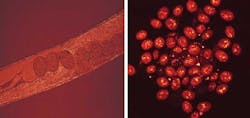ULTRAFAST LASERS: CARS ultrafast light source is hands-free
HEINZ P. HUBER, SANDRA ZOPPEL, and INGO RIMKE
In the last ten years, multiphoton microscopy has become increasingly popular for enhancing contrast and resolution in microscopic imaging by exploiting nonlinear optical effects. These nonlinear effects scale down the lateral and longitudinal resolution of the image with the intensity of the illumination light, enabling microscopic three-dimensional imaging. Among many methods of multiphoton microscopy, two-photon-excitation fluorescence microscopy is the most popular, with at least a few hundred systems installed every year.1 Two-photon microscopy uses the simultaneous absorption of two photons to excite a dye molecule, with the goal of generating fluorescence in a spectral region of the electromagnetic spectrum that is blue-shifted when compared to the excitation wavelength.
A tunable femtosecond laser is used as the light source for two-photon excitation. The fluorescence signal is easily detected from the excitation background in a confocal microscope, and the dye molecules can be tailored to visualize almost any physiological process seen in the modern life sciences.
The big drawback of two-photon-fluorescence microscopy, however, is the use of dyes for creating the images, due to their toxic effects in vivo that can change the physiology. Fluorescent proteins, such as the green fluorescent protein, are often used instead of dyes, but this approach involves complicated genetic sample-preparation techniques. Additionally, these dyes show photobleaching within a time span of minutes, which causes the fluorescence signal to gradually fade.
Methods to overcome the problems connected with dyes are based on nonlinear optical effects such as second- or third-harmonic generation (SHG or THG), Raman scattering, or coherent anti-Stokes Raman scattering (CARS)–a third-order nonlinear process (the X(3) process) that involves four photons.
In CARS, a pump field at the frequency ωp and a Stokes field at ωs excite the sample to a virtual state and induce molecular vibrations at the difference frequency ωp – ωs. The excitation of these vibrations is most effective if ωp – ωs equals the characteristic Raman frequency Ω of the molecule. The anti-Stokes sideband at the frequency ωas = (ωp – ωs) + ωp, which is the signal that is finally measured, is generated by the X(3) process (see Fig. 1). With the actively driven oscillations and the coherent signal generation, it is possible to achieve much stronger signals with CARS than with conventional Raman scattering.
The use of CARS for microscopic imaging creates contrast without dyes, yielding a strong spectrally blue-shifted signal at the frequency ωas, which can be easily detected and discriminated from the excitation fluorescence background (see Fig. 2). The CARS signal is sensitive to vibrational modes of the sample and images the density of molecular oscillators in the living object.
Because there are four photons involved in the process with two colors (pump and Stokes pulse) from the pump source, these two pulses need to be perfectly overlapped in time. This was previously achieved using two electronically synchronized titanium sapphire (Ti:sapphire) femtosecond lasers, with the consequent disadvantage of a temporal jitter that led to a strongly fluctuating CARS signal. In contrast to this earlier approach, the use of a laser combined with a synchronously pumped OPO is intrinsically jitter-free; such an approach has been realized with a high-power picosecond laser synchronously pumping an optical parametric oscillator (OPO), and was developed by APE and High Q Laser in collaboration with Sunney Xie’s research group at Harvard University (Cambridge, MA).3 This approach had a built-in temporal synchronicity and spatial overlap and was well-received and widely used in the CARS community, but still consisted of two equipment housings.
Shrinking the source
As CARS microscopy has migrated from physics labs into life-science labs, the demand for an easy-to-use, turnkey light source has increased. In response, High Q Laser and APE joined forces to develop a remote-controlled, truly hands-free single-box CARS light source—“picoEmerald,”—which provides two tunable ultrafast pulse trains from a single beam exit.
The picosecond oscillator is based on a misalignment-stability-optimized resonator with only one active laser stage that produces 4 W at 532 nm and 80 MHz in a temporally and spatially diffraction-limited beam. In addition, the resonator can be actively stabilized for maintaining optimum power over the system lifetime.
At first glance, the technology inside the OPO appears the same in comparison to the older Emerald laser, with temperature-tuned noncritical phase-matched lithium triborate as a gain medium and a Lyot filter for wavelength fine-tuning. But the fact that the size of the overall system, including the pump laser and the beam shaping, is only 70% of the previous OPO shows the dramatic reduction in size, with a new cavity design optimized by finite-element methods for maximum passive stability and machined into a single block of aluminum. Any remaining drift is compensated by actively stabilizing control elements such as cavity length and mirror tilt; everything is controlled via PC or microscope software, with no mirrors exposed for manual tweaking.
The standard CARS setup relies on 1064 nm light for the Stokes pulse and the signal pulse train as pump, with an energy difference from 700 to 5000 cm-1. Other CARS setups use the signal and idler pulse trains (1400 to 10,000 cm-1) for the higher penetration depths that result from the red-shifted excitation wavelengths.4
In contrast, the picoEmerald supplies three fully automated temporally and spatially overlapping ultrafast pulse trains: 1064 nm out of the laser oscillator itself, and from 690 to 990 nm (signal range) and 1150 to 2300 nm (idler range) from the OPO. The controller inside the OPO takes care of the power stability and wavelength tuning; the pump and Stokes beams are tailored to be sent into the microscope. The microscope user needs only to decide which mode to work in: signal and idler or signal and 1064 nm, and how much laser power should be applied.
In the first mode, the signal and idler leave the OPO resonator perfectly overlapped in space and time, allowing greater penetration depth due to red shifted excitation beams with a tuning range from 1350 to greater than 10,000 cm-1. In the second mode, the OPO signal is mixed with the 1064 nm pulses from the pump laser with a tuning range of 650 to greater than 5000 cm-1, which is the setup preferred by most researchers so far.
Unlike previous systems, in which the user had to adjust the pulse overlap in space and time, this is done inside the laser. Sensors for the overlap do a check for a first alignment. The time overlap is measured at the exit of the OPO, and may be slightly different from the overlap at the sample side due to dispersion of the microscope. The initial delay will be good enough to generate CARS signals; it can then be electronically optimized for maximum brightness. The 1064 nm beam and the signal/idler beam can be attenuated to the desired power level. This power level is monitored and is kept constant over time to allow measurement periods as long as overnight.
The vibrational excitation modes of the molecules excited by CARS microscopy typically have a bandwidth on the order of 10 cm-1. This corresponds to a pulse duration of around 2 ps for transform-limited pulses; shorter pulses than this decrease the spectral resolution, while much longer pulses decrease the effectiveness of the CARS four-wave-mixing process. The picoEmerald delivers 7 ps at 1064 nm and 5 to 6 ps from the OPO to balance these requirements almost ideally.
New microscopy approaches
In addition to the advantages of CARS in comparison to other imaging techniques, there are some drawbacks. The most important is a relatively strong nonresonant background independent of the wavelength, which leads to spectral shapes different from those produced by Raman spectroscopy, and which limit detection sensitivity.
One solution to this problem, stimulated Raman scattering (SRS), has been demonstrated by several groups. The most sensitive results so far were achieved by Sunney Xie’s group with a Levante Emerald OPO system.5 Here, in addition to the standard CARS setup, an intensity modulator is placed in one of the beams (for instance the Stokes beam); the resulting intensity modulation of the other (for instance the pump beam, in the form of stimulated Raman loss) is detected. However, the modulation is four to eight orders of magnitude smaller than the signal, which requires good lock-in amplification techniques. Even so, the results show an improved sensitivity in comparison to CARS, direct extraction of Raman spectra, and a signal intensity linearly proportional to the sample concentration.
Another promising technique for nonresonant background reduction is heterodyne CARS.6 This approach relies on the OPO being pumped by the SHG of the pump laser’s 1064 nm light. Using the 1064 nm beam as pump, and the OPO idler beam as Stokes leads to a CARS signal with a wavelength exactly the same as that of the OPO signal beam. By frequency-modulating the 1064 nm beam with an acousto-optical element and overlapping the CARS signal with the signal from the OPO, lock-in amplification techniques can be applied to extract the imaginary part of X(3)—that is, to extract the Raman signal and suppress the nonresonant background. Because both techniques require modulation in the 1064 nm arm, an optional acousto-optic modulator is planned for the next picoEmerald.
REFERENCES
- W. Denk et al., Science 248 (4951) p. 73 (1990).
- A. Zumbusch et al., Phys. Rev. Lett. 82, p. 4014 (1999).
- E. Büttner et al., Proc. SPIE 6442, 64420C (2007).
- F. Ganikhanov et al., Optics Lett. 31, p. 1292 (2006).
- C. W. Freudiger et al., Science 322, p. 1857 (2008).
- M. Jurna et al., Optics Express 15 (23) p. 15207 (2007).
Heinz P. Huber is senior sales and applications manager and Sandra Zoppel is marketing and communications manager at High Q Laser Innovation, Kaiser-Franz-Josef-Str. 61, A-6845 Hohenems, Austria; e-mail: [email protected]; www.highq-us.com. Heinz P. Huber is also professor for photonics and laser technology at the Munich University of Applied Sciences, Munich, Germany. Ingo Rimke is a research and development scientist at APE, Plauener Str. 163-165, Haus N, 13053 Berlin, Germany.

